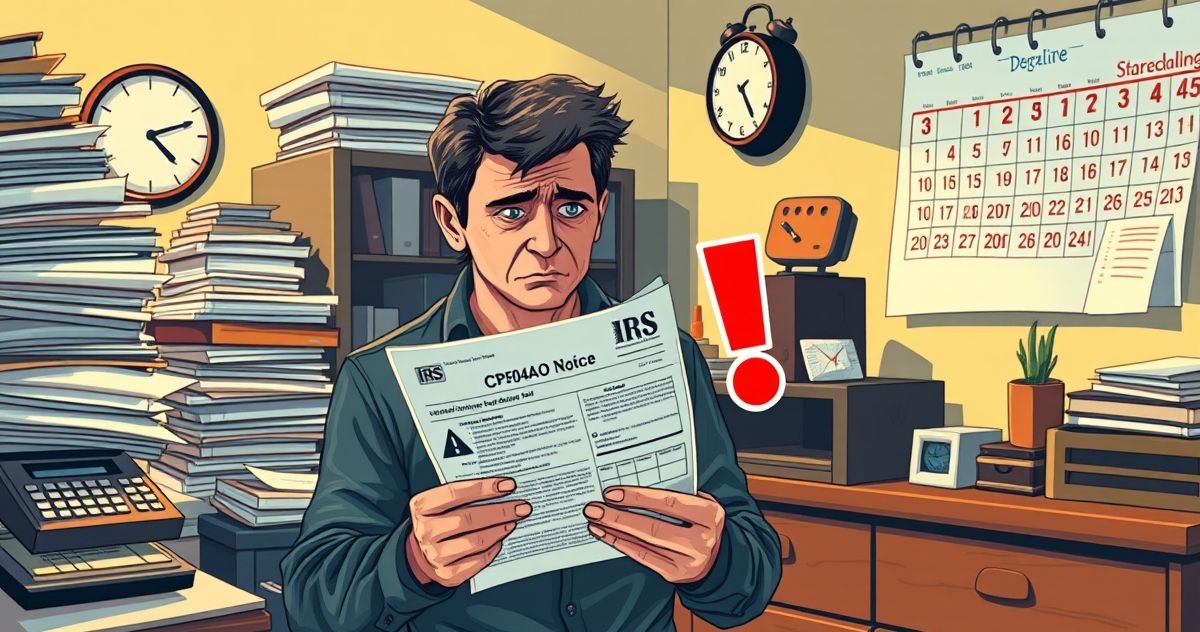Understanding the CP504AO Notice
The CP504AO Notice, often referred to as a CP504 Notice, is a critical communication from the Internal Revenue Service (IRS), signifying a taxpayer’s outstanding tax debt that remains unresolved. This notice is colloquially known as a ‘Notice of Intent to Levy’ and serves as a final reminder for taxpayers before the IRS proceeds with more aggressive collection actions, such as asset seizures.
What is the CP504AO Notice?
The CP504AO Notice is sent out by the IRS to alert taxpayers that they have a specified amount of unpaid tax debt. It warns that if this debt is not settled promptly, the IRS intends to levy the taxpayer’s state tax refund as a preliminary step towards further collection activities.
This notice is part of a series of IRS notices designed to increase taxpayer awareness and prompt compliance. Receiving a CP504AO should be a wake-up call to resolve unpaid taxes swiftly to avoid more severe consequences.
Key Features or Components of the CP504AO Notice
- Alert of Due Tax Debt: The notice explicitly states the outstanding tax amount, including any accrued penalties and interest.
- Intent to Levy: Specifies the IRS’s intention to levy, starting with the taxpayer’s state tax refund, and potentially expanding to other assets if the debt remains unpaid.
- Enforcement Warning: Notifies the taxpayer of further enforcement actions that may ensue, such as wage garnishments or bank levies.
- Contact Information: Provides contact details and steps the taxpayer can take to remedy the situation, including payment arrangements and resolution options.
Filing or Compliance Requirements
Once a CP504AO Notice is received, the taxpayer should take the following steps to ensure compliance and avoid enforcement measures:
- Verify the Claims: Review the notice for accuracy, confirming the listed debt amount and any prior payments made.
- Contact the IRS: Reach out directly through the provided contact channels to discuss the notice and any discrepancies or to request additional information.
- Payment in Full: The most straightforward way to resolve the CP504AO is by paying the full amount due. This can usually be completed through IRS online payment portals, phone systems, or mail.
- Payment Arrangements: If paying in full is not feasible, taxpayers can negotiate an installment agreement or another payment plan with the IRS.
Penalties or Consequences for Non-Compliance
Ignoring a CP504AO Notice can lead to significant financial distress. The immediate consequence is the levy on state tax refunds. However, unresolved debts beyond this can prompt the IRS to take more aggressive actions such as:
- Bank Levies: The IRS may seize funds directly from the taxpayer’s bank accounts.
- Wage Garnishments: Taxpayers’ employers will be ordered to redirect a portion of wages to settle the outstanding tax debt.
- Additional Liens: Further tax liens may be placed on properties owned by the taxpayer, complicating asset sale or refinance processes.
Importance of the CP504AO Notice
This notice represents a final chance for taxpayers to engage with the IRS before facing severe recovery actions. Addressing the CP504AO promptly can help preserve asset control and prevent additional stress or costs associated with enforced collections. By responding proactively:
- Financial Stability: Taxpayers can maintain financial stability by arranging to settle debts or agree on practical payment solutions.
- Asset Protection: Early action prevents forced seizures or sales of personal assets, securing ongoing economic safety.
- Negotiate Easier Terms: Engaging early may allow taxpayers to negotiate more favorable terms for repayment, aligning better with their financial capacities.
The CP504AO Notice is a crucial component of tax compliance, urging timely resolution of tax debts. By understanding its significance and responding efficiently, taxpayers can navigate IRS obligations without falling into deeper financial hardship.

